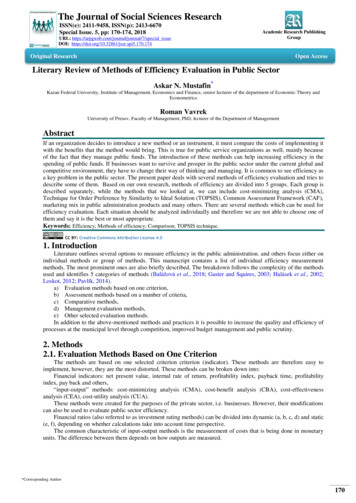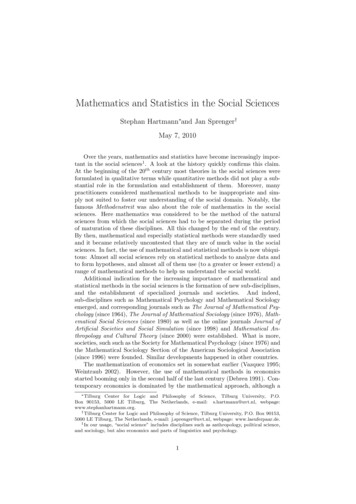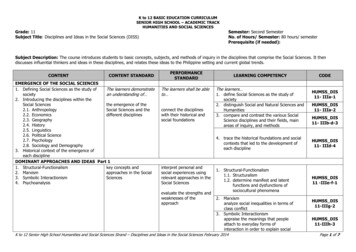
Transcription
The Journal of Social Sciences ResearchISSN(e): 2411-9458, ISSN(p): 2413-6670Special Issue. 5, pp: 170-174, 2018URL: https://arpgweb.com/journal/journal/7/special issueDOI: https://doi.org/10.32861/jssr.spi5.170.174Academic Research PublishingGroupOriginal ResearchOpen AccessLiterary Review of Methods of Efficiency Evaluation in Public SectorAskar N. Mustafin*Kazan Federal University, Institute of Management, Economics and Finance, senior lecturer of the department of Economic Theory andEconometricsRoman VavrekUniversity of Presov, Faculty of Management, PhD, lecturer of the Department of ManagementAbstractIf an organization decides to introduce a new method or an instrument, it must compare the costs of implementing itwith the benefits that the method would bring. This is true for public service organizations as well, mainly becauseof the fact that they manage public funds. The introduction of these methods can help increasing efficiency in thespending of public funds. If businesses want to survive and prosper in the public sector under the current global andcompetitive environment, they have to change their way of thinking and managing. It is common to see efficiency asa key problem in the public sector. The present paper deals with several methods of efficiency evaluation and tries todescribe some of them. Based on our own research, methods of efficiency are divided into 5 groups. Each group isdescribed separately, while the methods that we looked at, we can include cost-minimizing analysis (CMA),Technique for Order Preference by Similarity to Ideal Solution (TOPSIS), Common Assessment Framework (CAF),marketing mix in public administration products and many others. There are several methods which can be used forefficiency evaluation. Each situation should be analyzed individually and therefore we are not able to choose one ofthem and say it is the best or most appropriate.Keywords: Efficiency; Methods of efficiency; Comparison; TOPSIS technique.CC BY: Creative Commons Attribution License 4.01. IntroductionLiterature outlines several options to measure efficiency in the public administration. and others focus either onindividual methods or group of methods. This manuscript contains a list of individual efficiency measurementmethods. The most prominent ones are also briefly described. The breakdown follows the complexity of the methodsused and identifies 5 categories of methods (Balážová et al., 2018; Gaster and Squires, 2003; Halásek et al., 2002;Loskot, 2012; Pavlík, 2014).a) Evaluation methods based on one criterion,b) Assessment methods based on a number of criteria,c) Comparative methods,d) Management evaluation methods,e) Other selected evaluation methods.In addition to the above-mentioned methods and practices it is possible to increase the quality and efficiency ofprocesses at the municipal level through competition, improved budget management and public scrutiny.2. Methods2.1. Evaluation Methods Based on One CriterionThe methods are based on one selected criterion criterion (indicator). These methods are therefore easy toimplement, however, they are the most distorted. These methods can be broken down into:Financial indicators: net present value, internal rate of return, profitability index, payback time, profitabilityindex, pay back and others,“input-output” methods: cost-minimizing analysis (CMA), cost-benefit analysis (CBA), cost-effectivenessanalysis (CEA), cost-utility analysis (CUA).These methods were created for the purposes of the private sector, i.e. businesses. However, their modificationscan also be used to evaluate public sector efficiency.Financial ratios (also referred to as investment rating methods) can be divided into dynamic (a, b, c, d) and static(e, f), depending on whether calculations take into account time perspective.The common characteristic of input-output methods is the measurement of costs that is being done in monetaryunits. The difference between them depends on how outputs are measured.*Corresponding Author170
The Journal of Social Sciences ResearchTable-1. Comparison of outputs of “input-output” methodsMethodCMACBACEACUAOutput measurementis not measuredmonetary unitsnumber of output unitsproject’s benefits2.2. Evaluation Methods Based on Multiple CriteriaIn order to make purposeful and effective decisions on management of the development of human capital both atthe micro and meso levels there is a need in objective information basis and analytical tools for the analysis of thecurrent situation and planning for further actions (Mustafin and Ignateva, 2016). Efficiency evaluation based onmultiple criteria is a more complicated option, but on the other hand, this evaluation gives more insight into the realstate of public sector efficiency. According to Vrabková et al. (2016), the basic advantage of these methods is thefact that they are not in a position to transform non-economic criteria into economic criteria at the cost of delicate,sometimes controversial operations. These methods include:Scales and ranges (can be used separately or as a part of another method),Methods of weight determination: equal importance, ranking, scoring method (qualitative criteria), Fuller’smethod (paired comparison method), Saaty's method,Methods based on partial evaluation of variants: weighted sum method, basic variant,Methods based on pairwise comparison of variants: lexicographic method, AHP (Analytic Hierarchy Process),TOPSIS (Technique for Order Preference by Similarity to Ideal Solution).All multi-criteria evaluation methods work with criteria (indicators) that are non-negative and normalized, i.e.their sum is 1.The method of equal importance is not able to distinguish between the greater or lesser importance of theobserved criteria, i.e., all criteria are evaluated equally. Ranking is based on assigning a point value based on certainpreferences. The scoring method is similar to the previous method, but works with cardinal variables (preference ofindividual indicators). The principle of the Fuller’s method is to allocate the points to each pair of indicators and thento sum up the points obtained (Khasheva et al., 2017; Vavrek et al., 2015; Vavrek et al., 2017; Vrabková et al.,2016). Used this method to evaluate municipalities in the Slovak Republic. Saaty's method works much like theprevious methods. The only difference is that it also determines the size of this preference. The weighted summethod is particularly suited to determine quantitative criteria, assuming a linear dependence of the utility rate oncriteria (indicators). The basic variant method determines the best or desired values and then calculates the utilityrate of each alternative.The lexicographic method is based on the assumption that the most important criterion has the greatestinfluence. In the case of compliance, the second and the criterion after that shall be taken into account. When solvinga problem the AHP method takes into account all the elements that affect the outcome (the links between them andthe intensity with which they influence each other). The TOPSIS method chooses the variant that is closest to thepre-set ideal and at the same time the furthest from the basal variant (Šebestová, 2008).2.3. Comparative, Managerial and Other Evaluation MethodsComparative methods represent the foundation of management methods. According to Peková et al. (2002),they are based on a territorial or institutional comparison of the cost of public goods production. Their use assumesthe right choice of comparative variables. For the greatest objectivity of comparison, it is required that thecomparative indicators have the same scope and apply to the same constant. These methods include:Comparison over time: at the local, regional or state level, at the level of the municipality or a set ofmunicipalities, at the level of the managed entity (budget, contribution, other non-profit organizations),Comparison with regard to place: at the local, regional or state level, at the level of the municipality or a set ofmunicipalities, at the level of the managed entity (budget, contribution, other non-profit organizations).Managerial methods have been known to the private sector for a long time. They improve the quality ofmanagement, which is together with modernization the main premise for increasing the efficiency of funds use.These methods include:Benchmarking,Benchlearnig,CAF model,Balanced scorecard (BSC method),SWOT analysis,Quality management system based on ISO standards,The PDCA Improvement Cycle, Deming cycle.The basis for benchmarking in public administration is the so-called metric benchmarking. The data obtainedshould be converted to indicators based on which it is possible to draw conclusions and make changes. break downthe public sector performance indicators into four categories:Workload indicators (outputs),Effectiveness indicators,Efficiency indicators (results),171
The Journal of Social Sciences ResearchProductivity indicators. points to its use in the public administration of the Czech Republic, especially bymunicipalities with extended competence. As an alternative to benchmarking offer benchlearning, which is alsobased on the notion of learning from others. The aim of benchlearning is to learn from other subjects everything theyknow better and to look for inspiration.The CAF model is tailored to public sector institutions. It could be considers self-evaluation to be its basis sinceit helps organizations with identification of their strengths and it also provides an overview of the activities leadingto continuous improvement in their performance. considers this model a comprehensive method that improves thequality of public sector institutions. According to Provazníková (2009)., the model is intended for/to: Setting up,mastering and developing the minimum quality management standard, Regular self-assessment and critical selfreflection of the current state of learning, Setting up a basis for external evaluation, comparison and cooperation, Theunification of the quality management method (Khasheva et al., 2017).Figure-1. Model CAFThe introduction of a Balanced Scorecard into the public sector can be, according to Mustafin et al. (2017),divided into several interconnected and sequential steps:Formulation of the goal (in the public sector it is mostly fixed),Implementation of a critical assessment of the current situation (in the form of SWOT analysis, PEST analysis,financial analysis or demographic study),Defining a real vision (design of the future state and activities of the organization),Plan for the implementation of methods (scope, team, implementation plan, support),Identifying relevant perspectives and key success factors (development activities, citizens' attitudes),Drawing up a strategic map (illustration and clarification of relations between the areas),Defining strategic objectives and set of indicators (quantitative and qualitative indicators),Identifying strategic initiatives (actions, measures and objectives for implementing the strategy),Delegation of BSC to lower units and individuals.see clarity, balance, measurability and creation of a basis for remuneration of employees as the main advantagesof the BSC method (Vavrek et al., 2015).2.4. Other Selected Methods for Evaluating EffectivenessMethods included in this group have not been included in the previous categories or were listed only rarely. Themethods include:Community planning,Healthy City Project,Local Agenda 21,Marketing mix for a public administration product,EMAS environmental management system,Citizen Charter,Evaluation of the creditworthiness of the municipality.Bělonohý I. understands Local Agenda 21 as a process that improves the quality of life in all its aspects throughthe improvement of governance, strategic planning and management and public engagement (Vavrek et al., 2017).According to , Local Agenda 21 and EMAS are instruments that apply the principles of sustainable development atthe local and regional level (they focus on the citizen as a member of society). The Healthy City Project is a projectof the Czech Republic that supports strategic planning and urban development and provides assistance whenobtaining financial resources.The marketing mix in public administration products (i.e., a public property), which is shown in the followingtable, aids and simplifies communication between citizens and offices.172
The Journal of Social Sciences ResearchTable-2. The marketing mix in public administration productsPRODUCTRangeQualityLevelImageProduction BoardGuaranteesAdditional servicesPHYSICAL ENVIRONMENTEquipmentColourDispositionNoise levelAtmosphereMaterial ilityCost effectivenessDistribution methodPerception of customerFlexibilityservice valueDifferentiationSALES SUPPORTAdvertisingPersonal salePromotionPEOPLEEmployees:EducationSelection processBenefitsMotivationDemeanourInterpersonal nizationSpace for decision makingCooperation with customersCustomer guidanceThe course of c relationsPARTNERSHIPResidents, private, non-profit and public sectorMuch like the marketing mix in the private sphere the marketing mix in the public administration productscontains the core components described in Table 2. The difference lies in the fact it identifies the citizen as the coresubject of the marketing mix.According to, the method of evaluating the creditworthiness of the municipality is based on the assessment ofthe most important parameters of municipalities in order to assess their long-term stability. However, the method isnot primarily designed to assess the ability of the municipality to guarantee compliance with debt obligations.Instead, it should be used to improve the performance of municipalities in the Czech Republic in a comprehensiveway by means of benchmarking with other municipalities. With regard to functional structure of the budget andcontent the monitored parameters are subdivided into three groups:Field P (revenues) - 6 indicators,Field V (expenses) - 8 indicators,Field R (the quality of the budgetary process and other characteristics of municipal management) - 8 indicators.3. DiscussionModernization and innovative development of economy are two interrelated sides of one fundamental processby which the state can optimize the accumulation, updating, distribution and use of tangible and intangible assets toincrease capacities for sustainable development Public economics involves economic activities of various economicentities that are owned by the state or other public organizations that are being directly influenced / financed by thestate. The management of public expenditures from the point of view of processes involved includes various types ofchecks (e.g. financial, accounting, legal). According to, the essence of the management of public expenditures lies inthe early detection of deviations from the original plan, their analysis and subsequent conclusions (Ochrana, 2007).states that the financial management in the public sector has three basic roles:Management and validation of the accuracy and integrity of financial procedures, records and reports oforganizations,Checking the purpose for which funds were used,Checking the effectiveness, economic efficiency and efficiency (3E) of expenditures in accordance withestablished priorities and rules.In the field of public administration an emphasis is being put especially on the economy, efficiency andeffectiveness of government organizations, tools, programs and higher quality of services provided. Less attention ispaid to adherence to formal procedures, rules and processes. However, the tendency towards inefficiency isconsidered to be the main problem from the long-term point of view.Based on our own experiences, there must always be a certain compromise between efficiency andrighteousness. Excessive preference for efficiency leads to social instability in society; on the other hand, too muchemphasis on righteousness slows down the economic growth and development. Each of above mentioned methodcould be used in practice. Using each of them is determined by the method and also by method itself.AcknowledgementsThe work is carried out according to the Russian Government s Program of Competitive Growth of KazanFederal University. This article was elaborated as a part of grants VEGA 1/0578/18, KEGA 038PU-4/2018, VEGA1/0139/16 and GaPU 1/2018.173
The Journal of Social Sciences ResearchReferencesBalážová, E., Papcunová, V. and Ágh, P. (2018). Comparison of incomes from ownership of municipal property inconditions of local self-government in the slovak republic and in the czech republic. Xxi. Mezinárodníkolokvium. 417.Gaster, L. and Squires, A. J. (2003). Providing quality in the public sector, A practical approach to improving publicservices. Open Univ Pr.Halásek, D., Pilný, J. and Tománek, P. (2002). The determining of creditworthiness of municipalities. VŠB – TUOstrava: Ostrava.Khasheva, Z. M., Golik, V. I., Shulgaty, L. P. and Ermishina, E. V. (2017). Economic justification of technologicaldiversification for the metal mining and production complex. Astra Salvensis - Review Of History AndCulture, 10: 361-67.Loskot, S. (2012). Model CAF in 201. Public Administration, 23(7): 8-9.Mustafin, A. N. and Ignateva, O. A. (2016). Formation of the human capital assessment quality model at the presentstage of development of innovative economy. Academy of Strategic Management Journal: 15.Mustafin, A. N., Bednárová, L. and Jusková, M. (2017). Use of regression analysis in municipal evaluation-casestudy. Journal of Fundamental and Applied Sciences, 9(1S): 1849-58.Ochrana, F. (2007). Basics of public finance. Central European Journal of Public Policy, 1(1): 122-27.Pavlík, M. (2014). Kolik peněz z veřejných rozpočtů jde vlastně na sport? Studia Sportiva, (1).Peková, J., Pilný, J. and Jetmar, M. (2002). Veřejná správa a finance veřejného sektoru. Praha, Aspi: 234.Provazníková, R. (2009). Financování měst, obcí a regionů–2. aktualizované a rozšířené vydání. GRADAPublishing as.Šebestová, J. (2008). Kontrolní systém veřejné správy a veřejného sektoru. Slezská univerzita v opavě, obchodněpodnikatelská fakulta v karviné.Vavrek, R., Kotulic, R. and Adamisin, P. (2015). Evaluation of municipalities management with the topsis techniqueemphasising on the impact of weights of established criteria. Lex Localis, 13(2): 249.Vavrek, R., Adamisin, P. and Kotulic, R. (2017). Multi-criteria evaluation of municipalities in Slovakia-case study inselected districts. Polish Journal of Management Studies: 16.Vrabková, I., Vaňková, I. and Ivan, I. (2016). The efficiency and public transport accessibility of indirect stateadministration in the czech republic. Review of Economic Perspectives, 16(2): 135-56.174
d) Management evaluation methods, e) Other selected evaluation methods. In addition to the above-mentioned methods and practices it is possible to increase the quality and efficiency of processes at the municipal level through competition, improved budget management and public scrutiny. 2. Methods 2.1. Evaluation Methods Based on One Criterion











